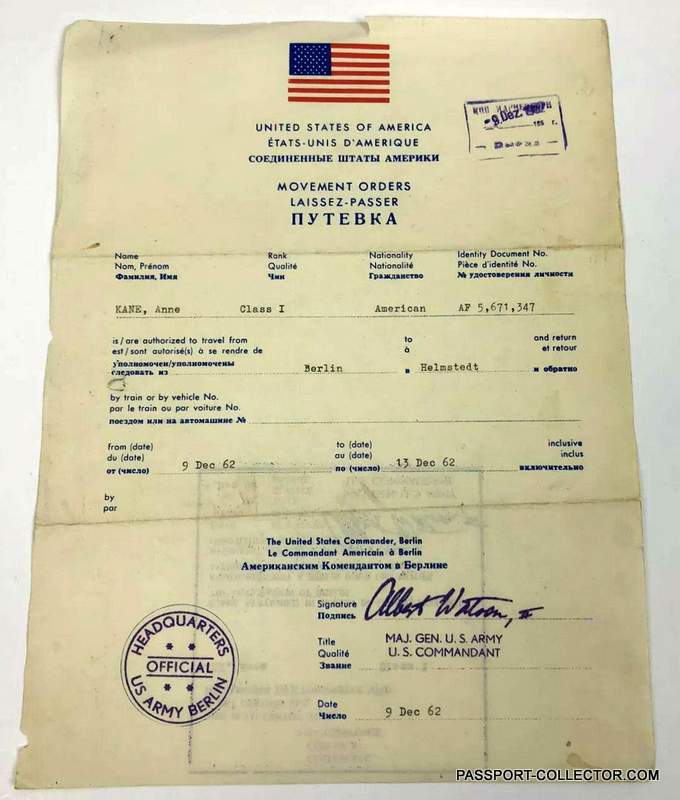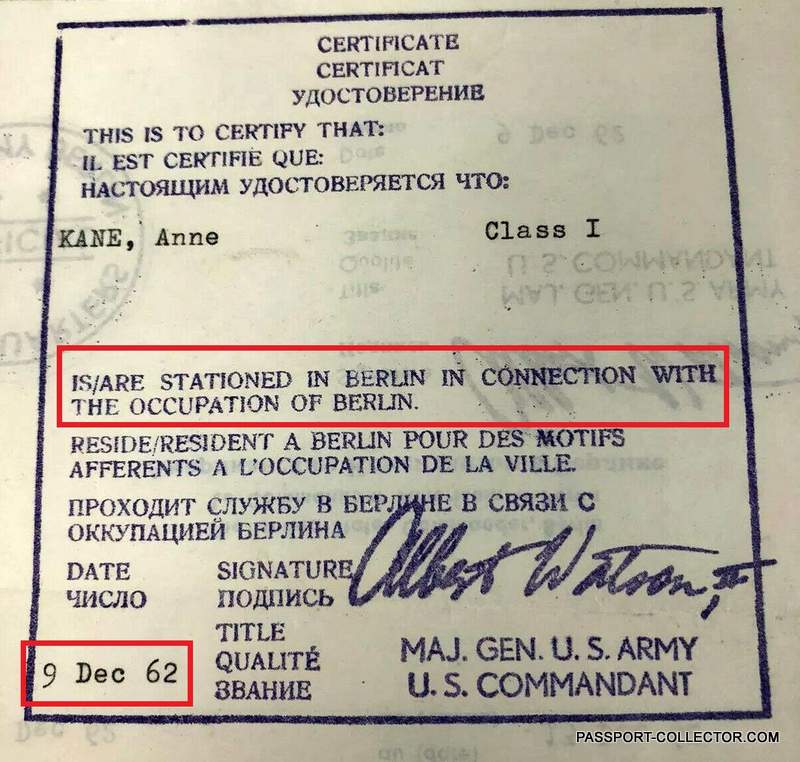A rare travel document from the Cold War and Occupation of Germany
travel cold war germany
After I had my morning coffee, I went to my computer and checked my emails when suddenly a message popped up with this document. I remember I have seen it before – at the Allied Museum in Berlin, Germany, back in 2012. The document I saw there was issued by the British, this one was issued by the Americans. And there are also documents issued by the Soviets.
Allied military personnel to drive the Berlin-Helmstedt autobahn had to have a military ID card, valid vehicle registration or license plates, and official travel orders or leave form. Most importantly, also to have a Movement Order.
What you see here is a rare Movement Order for Allied military personnel, internally known as “Flag Orders.” Flag Orders were individual travel documents printed in English, French, and Russian with the flag of the appropriate Allied nation at the top. Flag Orders were official permission to travel the Berlin-Helmstedt autobahn. travel cold war germany

It listed the name of the traveler, nationality, ID card number, date(s) of travel, license number of the vehicle, direction of travel, the signature of the issuing official and official stamp. The back of the Flag Orders had your name and rank, and a statement that someone was officially stationed in Berlin and the signature block of the issuing official.
Flag Orders had to be letter-perfect and perfectly match your ID. The Military Police carefully scrutinized them at the Allied checkpoints. An unduly worn or damaged ID was a reason for being turned back. The photo had to match your appearance. If you grew a mustache after your ID photo was taken, you would be set back unless you shaved it off at the Allied checkpoint.
No typographical errors or corrections were permitted. For example, if your ID card had dashes and your Flag Orders did not, you would be turned back. Same for the dash on your vehicle license plate or a comma between your last and first name. If you had been promoted and your Flag Orders listed your new rank, but you hadn’t updated your ID, you would be turned back. If the Allied MPs missed something and allowed you to proceed and the error was caught at a Soviet checkpoint, you would be turned back.
Checkpoint Bravo at Dreilinden
Allied travelers leaving West Berlin on the Berlin-Helmstedt autobahn were required to stop at Allied Check Point Bravo at Dreilinden in the American Sector. The checkpoint was manned seven days a week and 24 hours a day by military police of the three Western Allied nations. You presented your documents to the appropriate MP. Assuming all was in order, the MP paper-clipped your ID to the top of your Flag Orders on which he had placed the Checkpoint Bravo rubber stamp with your time of departure written on it and returned them to you.
Soviet Checkpoint (Nowawes/Drewitz)
After processing at Checkpoint Bravo you returned to your vehicle and got back on the autobahn. About two miles down the road, you entered East Germany at the Drewitz border crossing (Grenzübergangsstelle).
An access road marked for Allied traffic split off from the autobahn and led to the Soviet Checkpoint. Technically, the Soviet Checkpoint was at Drewitz. However, they continued to use the old location of Nowawes on their rubber stamps. Here, your paperwork was inspected, logged, the checkpoint’s stamp affixed, and time is written on it. They were then returned to you. You drove to the end of the checkpoint then back onto the autobahn through East Germany.
Soviet Checkpoint Marienborn
Arriving at the East German/West German border about two and a half hours later, you stopped at the Soviet Checkpoint at Marienborn. The layout of the checkpoint and the procedure there were identical to those at the Soviet Checkpoint at Drewitz (Nowawes): Your Flag Orders were inspected and logged, the checkpoint stamp affixed, and the time written on it. Departing the Soviet Checkpoint, you followed the lane marked for Allied traffic until you crossed into West Germany at Helmstedt.
Allied Checkpoint Alpha at Helmstedt
The final stop for Allied travelers on the Berlin-Helmstedt autobahn from West Berlin was Allied Checkpoint Alpha in Helmstedt, West Germany. You were required to check in with them so they could log your arrival. After processing, the MP affixed Checkpoint Alpha’s rubber stamp on the flag orders with the arrival time noted and returned them to you. You were then “free” to continue into West Germany.
Allied Access
The city of Berlin, 110 miles inside communist East Germany, had a special status. It was still occupied by the four Allied powers. The Soviet Sector encompassed the eastern half of the city-forming East Berlin. West Berlin consisted of the French Sector in the north, the British Sector in the west and, the American Sector in the south.
When the East Germans erected the Berlin Wall in August 1961, they also established a security zone around West Berlin, isolating it from East Germany. The US did not recognize East German authority over Allied access to West Berlin and declared that only the Soviet Union had that authority. A 1972 agreement confirmed the Allies’ rights of access to and from West Berlin under the control of the Soviets.
By agreement, Allied military personnel was restricted to using the Berlin-Helmstedt autobahn (officially East German Autobahn A2). The Soviets set up checkpoints at Drewitz and Marienborn to process Allied personnel for travel through East Germany. The Western Allies set up their checkpoints on the Berlin-Helmstedt autobahn. Allied Checkpoint Bravo was at Dreilinden in the American Sector of West Berlin opposite the Soviet checkpoint at Drewitz. At the far end, Allied Checkpoint Alpha at Helmstedt in West Germany was opposite the Soviet checkpoint at Marienborn.
According to Bruce E. Kipp, who served three tours of duty (1972-74, 1975-77, and 1980-83) with the U.S. Army Security Agency’s Field Station Berlin in the American Sector in what was then West Berlin. Military intelligence personnel with security clearances were not allowed to use the Berlin-Helmstedt autobahn. However, the rules had relaxed slightly so that military intelligence personnel could use the autobahn—but only in daylight and only if escorted by another vehicle driven by someone who did not have a security clearance who agreed beforehand to act as your escort. Later on, they had the same autobahn travel privilege as everyone else stationed in West Berlin.
Now, the displayed Movement Order was issued in December 1962, and on the back, we still find the following entry.

…IS STATIONED IN BERLIN IN CONNECTION WITH THE OCCUPATION OF BERLIN
Seventeen years after the end of WWII, the city of Berlin was still occupied!
Why?
Because of the General Treaty (Deutschlandvertrag) from 5 May 1955, which formally ended Germany’s status as an occupied territory and recognized its rights of a sovereign state, but with certain restrictions that remained in place until German reunification in 1990. The Allied Travel Board also issued until 1970 travel documents. They were titled “TEMPORARY TRAVEL DOCUMENT IN LIEU OF PASSPORT FOR GERMAN NATIONALS.”
Many thanks to Bruce E. Kipp who granted me permission to republish the article.
travel cold war germany
FAQ Passport History
Passport collection, passport renewal, old passports for sale, vintage passport, emergency passport renewal, same day passport, passport application, pasaporte passeport паспорт 护照 パスポート جواز سفر पासपोर्ट
1. What are the earliest known examples of passports, and how have they evolved?
The word "passport" came up only in the mid 15th Century. Before that, such documents were safe conducts, recommendations or protection letters. On a practical aspect, the earliest passport I have seen was from the mid 16th Century. Read more...
2. Are there any notable historical figures or personalities whose passports are highly sought after by collectors?
Every collector is doing well to define his collection focus, and yes, there are collectors looking for Celebrity passports and travel documents of historical figures like Winston Churchill, Brothers Grimm, Johann Wolfgang von Goethe. Read more...
3. How did passport designs and security features change throughout different periods in history, and what impact did these changes have on forgery prevention?
"Passports" before the 18th Century had a pure functional character. Security features were, in the best case, a watermark and a wax seal. Forgery, back then, was not an issue like it is nowadays. Only from the 1980s on, security features became a thing. A state-of-the-art passport nowadays has dozens of security features - visible and invisible. Some are known only by the security document printer itself. Read more...
4. What are some of the rarest and most valuable historical passports that have ever been sold or auctioned?
Lou Gehrig, Victor Tsoi, Marilyn Monroe, James Joyce, and Albert Einstein when it comes to the most expensive ones. Read more...
5. How do diplomatic passports differ from regular passports, and what makes them significant to collectors?
Such documents were often held by officials in high ranks, like ambassadors, consuls or special envoys. Furthermore, these travel documents are often frequently traveled. Hence, they hold a tapestry of stamps or visas. Partly from unusual places.
6. Can you provide insights into the stories behind specific historical passports that offer unique insights into past travel and migration trends?
A passport tells the story of its bearer and these stories can be everything - surprising, sad, vivid. Isabella Bird and her travels (1831-1904) or Mary Kingsley, a fearless Lady explorer.
7. What role did passports play during significant historical events, such as wartime travel restrictions or international treaties?
During war, a passport could have been a matter of life or death. Especially, when we are looking into WWII and the Holocaust. And yes, during that time, passports and similar documents were often forged to escape and save lives. Example...
8. How has the emergence of digital passports and biometric identification impacted the world of passport collecting?
Current modern passports having now often a sparkling, flashy design. This has mainly two reasons. 1. Improved security and 2. Displaying a countries' heritage, icons, and important figures or achievements. I can fully understand that those modern documents are wanted, especially by younger collectors.
9. Are there any specialized collections of passports, such as those from a specific country, era, or distinguished individuals?
Yes, the University of Western Sidney Library has e.g. a passport collection of the former prime minister Hon Edward Gough Whitlam and his wife Margaret. They are all diplomatic passports and I had the pleasure to apprise them. I hold e.g. a collection of almost all types of the German Empire passports (only 2 types are still missing). Also, my East German passport collection is quite extensive with pretty rare passport types.
10. Where can passport collectors find reliable resources and reputable sellers to expand their collection and learn more about passport history?
A good start is eBay, Delcampe, flea markets, garage or estate sales. The more significant travel documents you probably find at the classic auction houses. Sometimes I also offer documents from my archive/collection. See offers... As you are already here, you surely found a great source on the topic 😉
Other great sources are: Scottish Passports, The Nansen passport, The secret lives of diplomatic couriers
11. Is vintage passport collecting legal? What are the regulations and considerations collectors should know when acquiring historical passports?
First, it's important to stress that each country has its own laws when it comes to passports. Collecting old vintage passports for historical or educational reasons is safe and legal, or at least tolerated. More details on the legal aspects are here...
Does this article spark your curiosity about passport collecting and the history of passports? With this valuable information, you have a good basis to start your own passport collection.
Question? Contact me...

